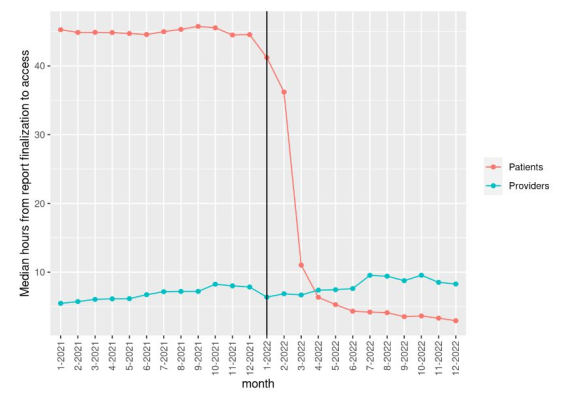
Median time (hours) from report finalization to first patient access in portal, as well as from report finalization to ordering provider acknowledgment in EMR—stratified by month. Vertical line represents health system’s implementation of regulations related to information-blocking provisions of Cures Act.
March 28, 2024 — Immediately releasing radiology reports under the 21st Century Cures Act (Cures Act) empowers patients and supports transparency, although the practice does introduce new concerns regarding radiologists’ communication, according to brand-new research from the American Journal of Roentgenology (AJR).

Nelly Tan, MD
“After implementing institutional policies to comply with Cures Act information-blocking provisions, the time for patients to access imaging results decreased, and the proportion of patients who accessed their reports before the ordering provider increased,” wrote senior and corresponding AJR author Nelly Tan, MD, from the radiology department at Mayo Clinic in Phoenix, AZ.
Tan et al.’s AJR manuscript included patients who underwent outpatient imaging examinations at three campuses within a large private academic health system (January 1, 2021–December 31, 2022), which implemented policies to comply with Cures Act information-blocking provisions on January 1, 2022. Imaging results were released in patient portals after a 36-hour embargo period before implementation—versus immediately upon report finalization after implementation. Data regarding patient report access in the portal and ordering provider report acknowledgment in the EMR were extracted and compared between periods.
Ultimately, median time from report finalization to patient access via portal was 47.3 hours before implementation of Cures Act information-blocking provisions, versus 8.9 hours after implementation. A total of 18.5% of reports were first accessed by the patient before the ordering provider before implementation, versus 44.0% after implementation.
Noting that imagers might need to tailor their reporting language to better contextualize their findings, “radiologists may also consider mechanisms for timely and appropriate communication of important findings to ordering providers, to ensure advance notification,” the authors of this AJR accepted manuscript added.
For more information: www.arrs.org


 July 31, 2024
July 31, 2024 








